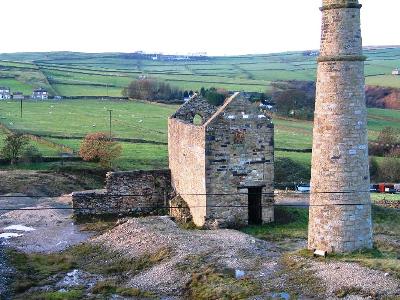 The Main Vein at Cononley crosses the parish boundary into Glusburn at a shallow angle, making it difficult to work as two separate mines. The vein outcrops in sandstone on Glusburn Moor, where it was worked intermittently from the sixteenth to the eighteenth century. In Cononley, however, it was covered by boulder clay and was ignored until the 1820s when Messrs Hall, of Newcastle, drove the Upper Adit and found some ore. They also began a Deep Adit, but were forced to abandon it in 1830 because of low lead prices. Because the sandstone is divided by beds of shale, parts of the vein were very poor and others rich.
The Main Vein at Cononley crosses the parish boundary into Glusburn at a shallow angle, making it difficult to work as two separate mines. The vein outcrops in sandstone on Glusburn Moor, where it was worked intermittently from the sixteenth to the eighteenth century. In Cononley, however, it was covered by boulder clay and was ignored until the 1820s when Messrs Hall, of Newcastle, drove the Upper Adit and found some ore. They also began a Deep Adit, but were forced to abandon it in 1830 because of low lead prices. Because the sandstone is divided by beds of shale, parts of the vein were very poor and others rich.
Stephen Eddy, the Duke of Devonshire’s agent at Grassington, resumed driving the Deep Adit in 1838 and sank the Engine and Taylor’s Shafts to cut the vein at adit level. The miners were soon into good ore and a smelt mill was built to treat it. Around 1843 the Duke was able to lease the Glusburn ground and could then work the entire vein as a single mine.
A steam engine was used for pumping at the Engine Shaft because the mine is near the top of a hill and had insufficient water to drive a waterwheel. The shaft was sunk to 82 metres below the adit, but the vein was poor below 45 metres. The engine also hauled waggons of ore up a 1 in 4 inclined plane from the stopes in the Main and South Veins in Glusburn.
From 1840 Cononley produced an average of 470 tons of lead ore per year until 1870, when output fell rapidly as the available ore was exhausted and new reserves were not found. The mine closed briefly in the slump of 1872, but reopened with a much smaller workforce before finally closing in 1881.
The barytes, which had been left as valueless by the lead miners, was in demand for a variety of industrial processes by the early twentieth century. Parts of the mine were reopened in order to work it, and more was recovered from the old waste dumps. In all some 19,600 tons were got in the 1920s and 1930s.
Return to previous page
